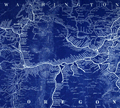| | Thumbnail | | Creator | Date | Title / Author / Date / Location | Price | | | Description |
| 4826 |  | Details | Union Pacific Railroad | 1933 |
| Map Oregon Washington Railroad and Navigation Company |
|
Union Pacific Railroad |
|
| 1933 |
| LOC:62 |
| $550.00 | Union-Pacific-Railroad | Map-Oregon-Washington-Railroad-and-Navigation-Company | Original cyanotype map (blueprint) of Oregon, Washington, and Idaho with the rail lines and stops of the Oregon-Washington Railroad and Navigation Company ca. 1933. Shows large and small railways some of which are now abandoned.
<br></br>
This map could be of interest for anyone with an interest in the Rails to Trails Conservancy or the Great American Rail-Trail initiative (a coast-to-coast multi-use trail of over 3,700 miles). Portions of this map includes abandoned tracks that are incorporated into that coast-to-coast trail including the Chicago, Milwaukee, St. Paul & Pacific Railroad (C. M. St. P and P.), now a part of the <b>Palouse to Cascades State Park Trail</b>.
<br></br>
Great detail and names of mountains in the Cascades Range including Mount Rainier, Mount St. Helens, Mount Adams, and Mount Hood. Coverage extends past Seattle to Everett, Washington.
<br></br>
The Oregon Railroad and Navigation Company operated from 1896 after a consolidation of several smaller railroads. Union Pacific (UP) purchased a majority stake of the line in 1898. In 1910 the line became a subsidiary of UP titled the <b>Oregon–Washington Railroad and Navigation Company.</b> Union Pacific formally absorbed the smaller railway into its system in 1936.
<br></br>
Dated 1933 based on 2 other similar items purchased in the same lot, each from the Chief Engineer's Office.
<br></br>
In the 1930's, minor abandonments of the company's Oregon lines included the partial abandonment of the line to Homestead, as well as joint operation with the Spokane, Portland & Seattle of the Oregon Trunk railroad line from the Columbia River south to Bend.
<br></br>
Drawn by REB. Published by the office of the Chief Engineer, Portland, Oregon. |